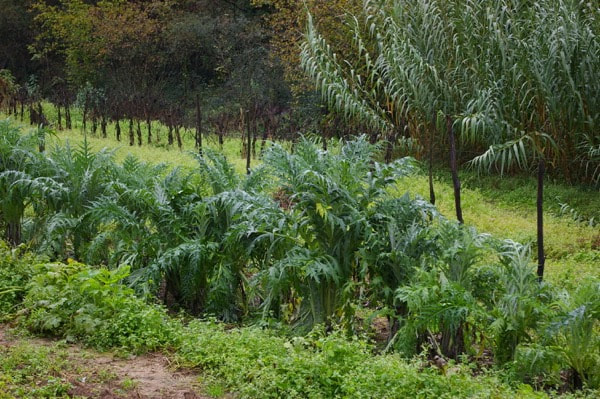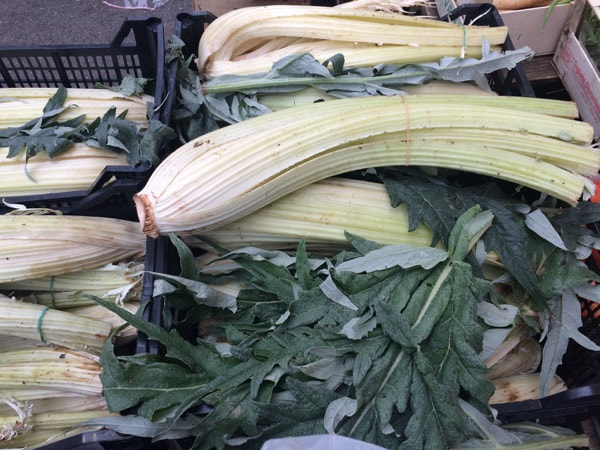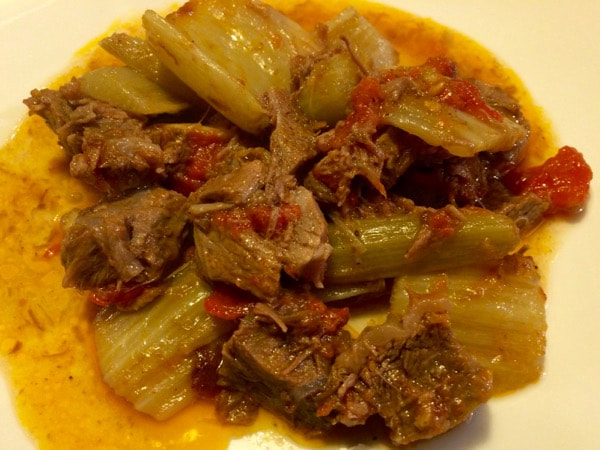|
In England when I used to prepare historical feasts for Christopher Hogwood and the Academy of Ancient Music, I pined futilely for a cardoon farmer. Cardoons cropped up regularly in recipes of the 17th and 18th centuries. I finally persuaded a friend to grow them on his allotment, but he planted them next to his artichokes, which are nearly identical, and couldn’t remember which was which. In culinary terms it matters; you eat the flower of an artichoke, but the stem of a cardoon. I can’t find any advice on what would happen if you ate the stem of an artichoke, and I didn’t try. Cardoons are common in Italian shops and markets from November to February. Although they are completely unrelated, they look like giant celery but surprise with a flavour of artichoke hearts. The heads come in two shapes, depending on how they’re grown: straight stalks which are called cardi, and curved ones called gobbi. Gobbo means ‘hunchback’, and touching an amulet of a gobbo is said to bring good fortune. Whichever the shape, the cultivation and preparation of cardoons is fiddly. During their last month in the field, the stems are blanched like celery, by piling up the earth or tying straw or paper around them so they lose their chlorophyl and become creamy white. If you’re growing them gobbo-style, you bend them in half before covering them with soil. In the kitchen you de-string them, cut them into chunks and boil them in acidulated water to keep them from rusting. They’re good eaten hot simply with a drizzle of this year’s extra-virgin olive oil. In the Abruzzo a traditional Christmas lunch begins with a soup of cardoons and meatballs. I’ve recently tried a Lucchese recipe for using up leftover bollito (boiled beef): infuse olive oil with garlic and sage leaves over a low heat, add chunks of boiled cardoons and sauté until they start to brown, add the boiled beef cut into cubes, stir well, deglaze the pan with white wine, add a few tinned tomatoes (not tasteless winter tomatoes) and simmer for 15 minutes. As long as you go light on the tomatoes, the flavours balance each other perfectly. Nutritionally cardoons are star players. They are said to have a fortifying and bracing effect on the stomach, protect the liver, reduce cholesterol and blood sugar levels. Who knows, maybe they’re the elixir of youth.
There’s an old variety called cardo gobbo of Nizza Monferrato from the province of Asti in Piedmont. Being on the brink of disappearance, Slow Food has recognised it as a presidium. It grows on sandy soil with no fertilisers, chemical treatments or irrigation. Sown in May, by September the tall luxuriant stalks are ready to be bent over and covered with soil. The Slow Food website describes the plant dramatically attempting to liberate itself to get to the light. In the process of its struggles, it swells up and turns pure white. Once harvested and cleaned, it’s the only cardoon that can be eaten raw, and is an indispensable ingredient of bagna cauda, the typical Piemontese warm sauce based on garlic, extra-virgin olive oil and anchovies. Continuing the purple prose, ‘It’s not merely a dish but a convivial ritual. Simmering in the centre of the table in an earthware terrine, the diners dip the pieces of vegetable and bring them to their mouths, catching the oil on a chunk of bread.’ If you’ll excuse me, I’m off to Nizza Monferrato right now. Postscript: Some ingredients draw me to repeated research. I had written this piece before discovering that I also wrote about cardoons in January 2013: http://www.sapori-e-saperi.com/seasonal-eating-4-cardoons-2/
0 Comments
Your comment will be posted after it is approved.
Leave a Reply. |
Email Subscription
Click to subscribe to this blog and receive notifications of new posts by email. AuthorErica Jarman Categories
All
Archives
October 2023
|
|
copyright 2017 sapori-e-saperi.com | all rights reserved
|
Website by Reata Strickland Design




 RSS Feed
RSS Feed



